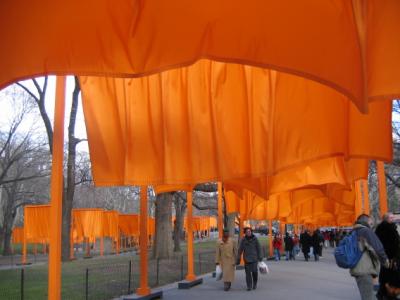According to the Central Park Conservancy, which sells official Gates merchandise at the Park’s entrance on 59th Street, 10 to 20 million people are expected to visit the park during the 16 days that The Gates are on display.
“February is the slowest month for tourism in the city and the exhibit has already brought an unexpected number to the park, which is usually dead in the winter,” said Central Park Conservancy staff member, Chris Trimbull, 25. She adds that, “I think it’s more popular than anyone had realized.”
Before The Gates opened, The New York Post printed that a mere 200,000 visitors were expected but the day after Mayor Michael Bloomberg kicked off the unfurling of 1,089,882 square feet of orange fabric, attendance had already hit 700,000 people.
Despite temperatures falling below freezing, last Friday thousands of people milled about, strolling beneath streaming saffron fabric along 23 miles of park paths.
Standing 16 feet high, The Gates attracted the young, elderly, tourists and students alike, who took photographs, held hands and observed the temporary display despite temperatures below freezing.
New York's AM station 1010 WINS recently conducted an online web poll asking if The Gates are art or a joke. Out of 1298 respondents, 65% said joke.
Lou Quillio agreed. With his sister and two daughters, he drove three hours from Saratoga, NY, to see the golden gates. “It’s just a thing, it’s less the art and more the social aspect," he said. "It’s an attraction and a spectacle,” said Quillio. But his sister Susan, however, disagreed, saying the primary attraction was asthetic. “It’s beautiful against all the gray rocks and bare trees.”
No matter what their opinion, everyone visiting the park seemed to discuss the artistic merits of the project, even talking to strangers in a city of people that rarely spare others a passing glance.
Beth Fichtel, who works in Manhattan, said her favorite part was not the 7,500 orange structures wrapped throughout the park, but the communal experience. “The energy in the air is contagious and it’s cool to be in something as enormous as Central Park and be surrounded by tons of people all talking about the same thing,” she said.
While he jogged underneath the colorful waving fabric, Manhattan resident Danny Schwartz asked, “I like it, but I don’t think it can be defined as art, but who’s to say really?”
Not 31-year-old, Laurie Carmen, whose job is to monitor The Gates, answer questions, and make sure that there are no hanging problems with the fabric. When the wind blows the billowing orange fabric around the steel poles, Carmen untangles it with 16-foot poles, which have tennis balls at the end to gently free the fabric. She states that there have not been any problems with vandalism so far, instead she says with a nod of her head, “It’s been pretty good.”
Architectural student Amanda Herron, 22, reverently believes that Christo and Jeanne-Claude’s work is highly creative and refused to miss their recent endeavor, so she flew in from Alabama just for the event.
“Their art is inspiring," she said. "We study their installations in school and how they are able to change a space dramatically, then leave and change what people originally thought of the space. It is so interesting, it comes and people soak it in, and then it’s gone.”
Herron further suspects that even after The Gates are removed, people will still be discussing them. For now, her theory is true. The Gates are a big topic of conversation and debate at the office, in the news and around the world.
